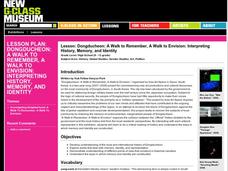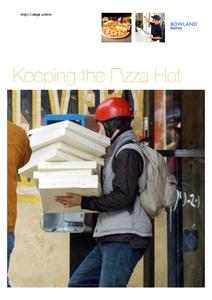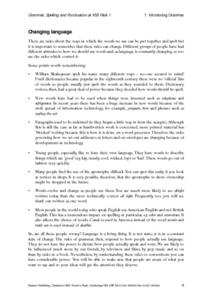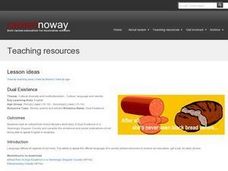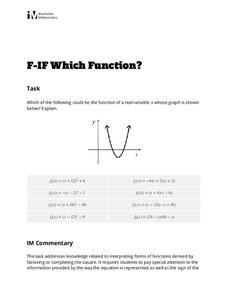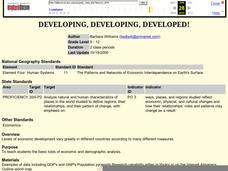Curated OER
Free Form Sculpture
Tenth graders explore abstract and non-representational art forms through research and artistic expression. They research a free form artist, their work, and abstract sculpture. They then work with pantyhose, chicken wire, plaster, and...
Curated OER
Target Earth
Space scientists use water displacement to determine the mass of a cubic centimeter mini meteorite, and then use it as a small-scale representative of an asteroid. They figure out the orbital velocity of an asteroid. Then they use a...
Curated OER
Lesson: Dongducheon: A Walk to Remember, A Walk to Envision: Interpreting History, Memory, and Identity
Cultural discourse can start through a variety of venues. Learners begin to think about how our minds, memories, and identities shape our attitudes toward culture and history. They analyze seven pieces from the Dongducheon art exhibit...
University of the Desert
How Do I Feel That My Culture Is Misunderstood by Others?
Using video clips of young adults from around the world describing their cultures and how they can be misunderstood, learners compare their own cultural point of view to that of others through discussion and writing.
Jamestown-Yorktown Foundation
Why Did Some Colonial Virginians Continue to Support the King?
Not all colonials supported the American Revolution. A resource from the American Revolution Museum at Yorktown ask young historians to investigate the reasons why some colonial Virginians were loyalist and continued to support King...
Curated OER
Condensation Polymerization
This organic chemistry lab activity is appropriate for teaching polymerization, percent yield, melting point, or the types and uses of polymer materials. Chemistry pupils imagine that they are working for a company to develop a special...
Curated OER
Condensation Polymerization: Preparation of Nylon 6/6
Students participate in a lab activity in which they synthesize nylon 6/6, calculate the percent yield by mass, identify the polymer as thermoplastic or thermoset, and determine the melting point, density and end-product use of the polymer.
Bowland
Keeping the Pizza Hot
Learners conduct an experiment to develop a cooling curve for pizza. They consider how this affects pizza delivery in terms of packing material, distance, and delivery routes.
Curated OER
ESL: Practice Tag Questions
Use this resource with your kids learning English as their second language. They read the short description of tag questions before attempting to complete 10 themselves.
Curated OER
Introducing Grammar: Grammar, Spelling, and Punctuation
Focusing on correct grammar usasge as well as the concept of language evolution, this conventions lesson prompts middle and high schoolers to examine the structure of sentences and word classes (parts of speech). Use the three activites...
Curated OER
Using the Web to Explore Shapes
Third graders research the Internet to locate geometric designs in familiar buildings. They review shapes, solids, angles and symmetry as they research websites of familiar buildings in Louisville. They record the information they see...
Curated OER
Dual Existence
Read an excerpt from Sonia Mycak's short story A Dual Existence in a Seemingly Singular Country and consider the emotional and social implications of not being able to speak English in Australia. This would be a great lesson for EFL...
Illustrative Mathematics
Which Function?
Learners are given a graph of a parabola on a coordinate system, but intercepts and vertex are not labeled. The task is to analyze eight given quadratic functions and determine which ones might possibly be represented by the graph. The...
Curated OER
Health - Respiration
Here is an interesting and engaging lesson on the lungs and the respiratory system. In it, fourth graders should gain a better understanding of how the lungs work and the role they play in supporting life. Some good, in-class partner...
Curated OER
Prefix/Suffix Challenge
Give your class practice recognizing prefixes and suffixes. They combine jumping rope with the practice of recognizing words with prefixes and suffixes. The activity aids both the heart and the brain, but make sure your class is...
Curated OER
Sexual Abuse: Sequoia's Story Discussion Guide
The subject matter of this lesson is intended for a mature academic audience. Please review to determine if it is suitable for your class. Students create a working definition of sexual abuse, read a scenario, and then break up into...
Curated OER
Vacancy: Habitats Available!
Sixth graders pick a native animal and write a classified housing ad to match the animal's habitat requirements, paste it on posterboard and then try to match each habitat with the animal it represents.
Curated OER
The Designed World
Students visit a school or public library and study how information is organized. For this information management lesson, students answer a group of questions about the organizational method of the library. Students then practice sorting...
Edgate
Why Map a Map?
After brainstorming reasons why Native Americans mapped their lands, your young critical thinkers will work together to review their ideas and determine the definition of a map. With today's extensive use of mapping technology and GPS...
Curated OER
Icky Sticky Fingers
Practice recognizing the short vowel /i/ in written and spoken language. Introduce the target sound with a fun tongue twister about Lizzy the lizard. Through matching and listening activities, learners discriminate the vowel sound /i/...
Curated OER
Finding Equations
Students make equations from everyday data. They create a graph from the equations. Students predict and analyze the results. Students complete the second scenario on their own and turn in their handout.
Curated OER
Louisville's Best Field Day Park
Students create a survey to hand out to determine the best field day park. Using their local area, they select five parks, if possible, that meet the criteria and calculate the distance and estimated time travel. They use this...
Curated OER
Developing, Developing, Developed!
Students differentiate among and explain various levels of economic development around the world. They see that levels of economic development vary greatly in different countries according to many different measures.
Curated OER
A Train of Shapes
Students review the names of the shapes by holding up each one and place the shapes on the work mat so that all children can see them. They then review attributes by posing different questions.


